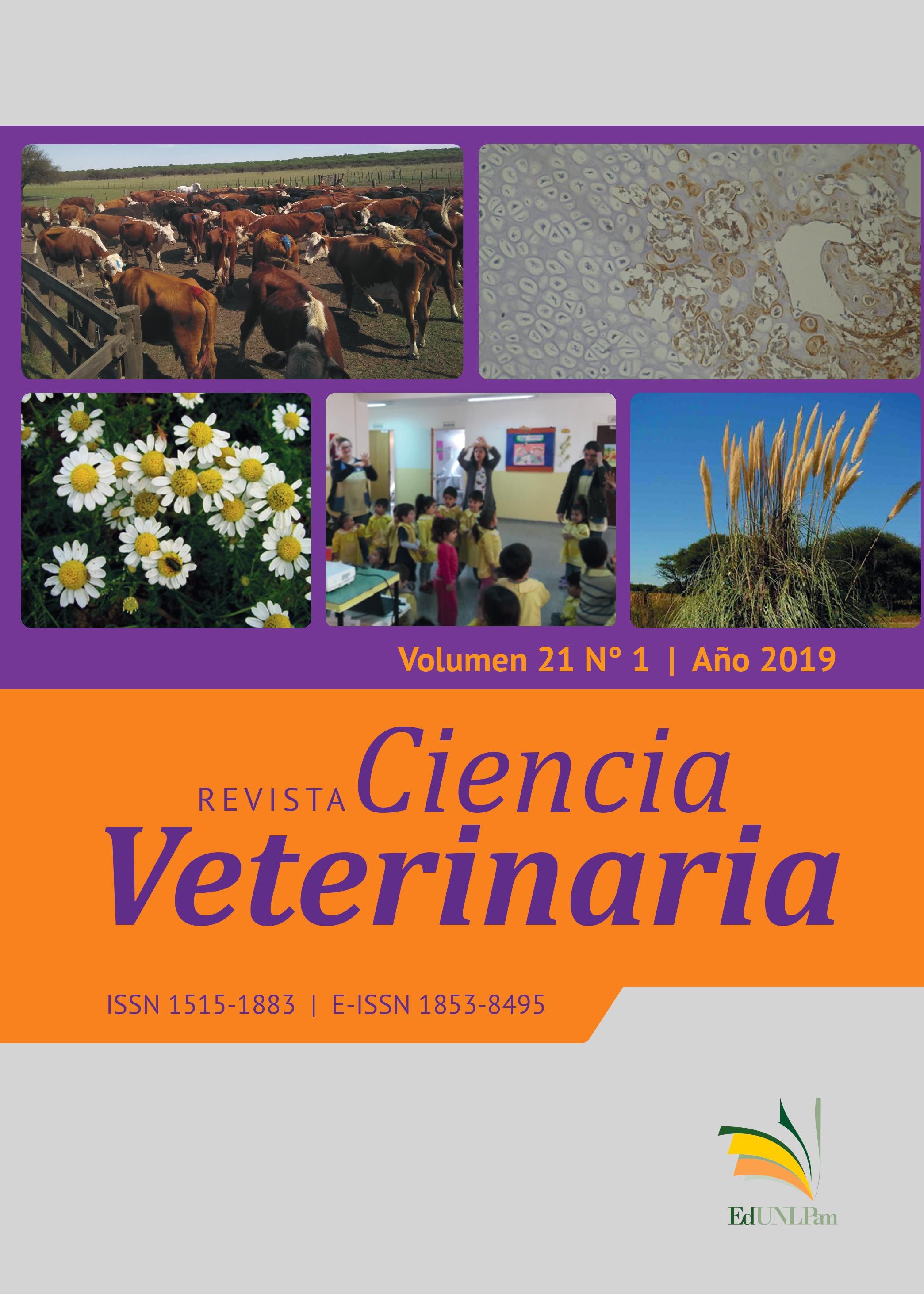El rol de osterix en la diferenciación osteoblástica: potencial en el tratamiento de afecciones osteoarticulares / The role of osterix in osteoblastic differentiation: Potential in the treatment of osteoarticular affections
DOI:
https://doi.org/10.19137/cienvet-201921101Palabras clave:
Osterix, preosteoblasto, osteoblasto, diferenciación celular, huesoResumen
El presente artículo hace revisión de la proteína Osterix y el rol que cumple en la esqueletogénesis, la osificación endocondral y en diversas patologías del sistema osteoarticular de los animales. Osterix es transcriptora de la familia de las proteínas morfogénicas ósea que inducen la formación de hueso. En la esqueletogénesis posibilita la diferenciación de los preosteoblastos en osteoblastos y la maduración y diferenciación de osteoblastos en osteocitos. En la osificación endocondral se expresa en los condrocitos maduros e hipermaduros y contribuye a degradar la matriz del cartílago. En la vida extrauterina colabora en la regulación de la homeostasis ósea e interviene en patologías osteoarticulares, oncología ósea y en la reparación de las fracturas. Conocer la acción de Osterix sobre las células óseas y condrocitos es un punto de partida atractivo para futuras investigaciones con el fin de contribuir con el diagnóstico y tratamiento de afecciones del sistema osteoarticular de los animales.
Descargas
Citas
Lin, G.L.; Hankenson, K.D. Integration of BMP, Wnt, and notch signaling pathways in osteoblast differentiation. J Cel Biochem.2011; 112:3491–501
Javed, A.; Chen, H.; Ghori, F.Y. Genetic and transcriptional control of bone formation. Oral Max Surg Clinics North Am. 2010; 22:283–293.
Nakashima, K.; Zhou, X.; Kunkel, G.; Zhang, Z.; Deng, J.M.; Behringer, R.R.; de Crombrugghe, B. The novel zinc finger-containing transcription factor osterix is required for osteoblast differentiation and bone formation. Cell. 2002; 108:17-29
Yagi, K.; Tsuji, K.; Nifuji, A.; Shinomiya, K.; Nakashima, K.; deCrombrugghe, B.; Noda, M. Bone morphogenetic protein-2 enhances osterix gene expression in chondrocytes. J. Cell. Biochem. 2003; 88:1077–1083
Zhou, X.; Zhang, Z.; Feng, J.Q.; Dusevich, V.M.; Sinha, K.; Zhang, H.; Darnay, B.G.; deCrombrugghe, B. Multiple functions of Osterix are required for bone growth and homeostasis in postnatal mice. Proc Nat Ac Sc.2010; 107:12919–12924.
Day, T.F.; Guo, X.; Garrett-Beal, L.; Yang, Y. Wnt/b-catenin signaling in mesenchymal progenitors controls osteoblast and chondrocyte differentiation during vertebrate skeletogenesis. Dev Cell. 2005; 8:739–750.
Baek, W.Y.; Lee, M.A.; Jung, J.W.; Kim, S.Y.; Akiyama, H.; Crombrugghe, B.; Kim, J.E. Positive regulation of adult bone formation by osteoblast-specific transcription factor osterix. J Bone Min Res. 2009; 24:1055-1065.
Baek WY, de Crombrugghe B, Kim JE. Postnatally induced inactivation of Osterix in osteoblasts results in the reduction of bone formation and maintenance. Bone.2010;46(4):920–928
Chen, S.X.; Feng, J.Q.; Zhang, H.; Jia, M.; Shen, Y.; Zong, Z.W. Key role for the transcriptional factor, osterix, in spine development. Spine J.2014; 14:683-694
Smok, C.; Rojas, M. Similitudes entre ontogenia y regeneración ósea post-fractura. Int. J Morph..2016 34(4):1293-129
Black, A.R.; Black, J.D.; Azizkhan-Clifford, J. Sp1 and krüppel-like factor family of transcription factors in cell growth regulation and cancer. J Cell Physiol.2001;
:143-160.
Zhang, C. Transcriptional regulation of bone formation by the osteoblast-specific transcription factor Osx. J Ortho Surg Res.2010; 5:37-45.
Hagh, M.F.; Noruzinia, M.; Mortazavi, Y.; Soleimani, M.; Kaviani, S.; Maymand, M.M. Zoledrinic acid induces osteoblastic differentiation of mesenchymal stem cells without change in hypomethylation status of osterix promoter. Cell J. 2012; 14:90-97
Komori, T.; Yagi, H.; Nomura, S.; Yamaguchi, A.; Sasaki, K.; Deguchi, K., Shimizu, Y.; Bronson, R.T.; Gao, Y.H.; Inada, M.; Sato, M.; Okamoto, R.; Kitamura, Y.; Yoshiki, S.;
Kishimoto, T. Targeted disruption of Cbfa1 results in a complete lack of bone formation owing to maturational arrest of osteoblasts. Cell. 1997; 89: 755–764.
Otto, F., Thornell, A.P.; Crompton, T.; Denzel, A.; Gilmour, K.C.; Rosewell, I.R.; Stamp, G.W.; Beddington, R.S.; Mundlos, S.; Olsen, B.R.; Selby, P.B.; Owen, M.J. Cbfa1, a candidate gene for cleidocranial dysplasia syndrome, is essential for osteoblast differentiation and bone development. Cell. 1997; 89:765–771.
Kobayashi H, Gao Y, Ueta C, Yamaguchi A, Komori T. Multilineage differentiation
of Cbfa1-deficient calvarial cells in vitro. Biochem Biophys Res Commun. 2000;
:630–636.
Nakashima, K.; deCrombrugghe, B. Transcriptional mechanisms in osteoblast differentiation and bone formation. Trends Genetics.2003; 19:458-66.
Galindo, M.; Pratap, J.; Young, D.W.; Hovhannisyan, H.; Im, H.J.; Choi, J.Y.; Lian, J.B.; Stein, J.L.; Stein, G.S.; vanWijnen, A.J. The bone-specific expression of Runx2 oscillates during the cell cycle to support a G1-related antiproliferative function in osteoblasts. J Biol Chem. 2005; 280:20274–20285
Jing J, Hinton RJ, Jing Y, Liu Y, Zhou X, Feng JQ. Osterix couples chondrogenesis and osteogenesis in post-natal condylar growth. J Dental Res.2014; 93:1014-1021.
Maes, C.; Kobayashi, T.; Selig, M.K.; Torrekens, S.; Roth, S.I.; Mackem, S.; Carmeliet, G.; Kronenberg, H.M. Osteoblast precursors, but not mature osteoblasts, move into developing and fractured bones along with invading blood vessels. Developmental cell. 2010; 19:329–344.
Tsuji, K.; Bandyopadhyay, A.; Harfe, B.D.; Cox, K.; Kakar, S.; Gerstenfeld, L.; Einhorn, T.; Tabin, C.J.; Rosen, V. BMP2 activity, although dispensable for bone formation, is required for the initiation of fracture healing. Nature Gen.2006; 38:1424-1429.
Nelson, W.J. Regulation of cell-cell adhesion by the cadherin-catenin complex. Biochem Soc Trans. 2008; 36:149-155.
Hill, T.P.; Spater, D.; Taketo, M.M.; Birchmeier, W.; Hartmann, C. Canonical Wnt/b-catenin signaling prevents osteoblasts from differentiating into chondrocytes. Dev Cell. 2005; 8:727–738.
Hu, H.; Hilton, M.J.; Tu, X.; Yu, K.; Ornitz, D.M.; Long, F. Sequential roles of Hedgehog and Wnt signaling in osteoblast development. Development. 2005; 132:49–60.
Tan, S.H.; Senarath-Yapac, K.; Chungc, M.T.; Longakerc, M.T.; Wud, J.Y.; Nusseb,
R. Wnts produced by Osterix-expressing osteolineage cells regulate their proliferation and differentiation. Proc. Natl. Acad. Sci. USA.2014; 5262–5271. DOI: 10.1073/ pnas.1420463111
Metzger, C.E.; Brezicha, J.E.; Elizondo, J.P.; Narayanan, S.A.; Hogan, H.A.; Bloomfield, S.A. Differential responses of mechanosensitive osteocyte proteins in fore- and hindlimbs of hindlimb-unloaded rats. Bone.2017; 105:26-34.
Barbutto, R.; Mitchell, J. Regulation of the osterix (Osx, Sp7) promoter by osterix and its inhibition by parathyroid hormone. J Mol Endocrinol.2013: 51:99–108.
Zhang, C.; Tang, W.; Li, Y.; Yang, F.; Dowd, D.R.; MacDonald, P.N. Osteoblast-Specific Transcription Factor Osterix Increases Vitamin D Receptor Gene Expression in Osteoblasts. PLoS ONE. 2011. DOI: https://doi.org/10.1371/journal.pone.0026504
Inada, M.; Wang, Y.; Byrne, M.H.; Rahman, M.U.; Miyaura, C.; López-Otín, C.; Krane, S.M. Critical roles for collagenase-3 (Mmp13) in development of growth plate cartilage and in endochondral ossification. Proc Natl Acad Sci USA.2004; 101:17192–17197
Nishimura, R.; Wakabayashi, M.; Hata, K.; Matsubara, T.; Honma, S.; Wakisaka, S.; Kiyonari, H.; Shioi, G.; Yamaguchi, A.; Tsumaki, N.; Akiyama, H.; Yoneda, T. Osterix regulates calcification and degradation of chondrogenic matrices through matrix metalloproteinase 13 (MMP13) expression in association with transcription factor Runx2 during endochondral ossification. J Biol Chem. 2012; 287:33179-33190.
Cao, Y.; Zhou, Z.; deCrombrugghe, B.; Nakashima, K.; Guan, H.; Duan, X.; Jia, S.F.; Kleinerman, E.S. Osterix, a transcription factor for osteoblast differentiation, mediates antitumor activity in murine osteosarcoma. Cancer Res. 2005; 65:1124-1128.
Wijesundera, K.K.; Izawa, T.; Fujita, D.; Denda, Y.; Seto, E.; Sasai, H.; Kuwamura, M.; Yamate, J. Spontaneous extraskeletal osteosarcoma in a rabbit (Oryctolagus cuniculus): histopathological and immunohistochemical findings. J Toxicol Pathol.2013;26:309–312.
Ma, X.L.; Liu, Z.P., Ma, J.X., Han, C, Zang, J.C. Dynamic expression of Runx2, Osterix and AJ18 in the femoral head of steroid-induced osteonecrosis in rats. Chinese Journal of Orthopaedics. 2010; 30:67-72.
Tu, Q.; Valverde, P.; Li, S.; Zhang, J.; Yang, P.; Chen, J. Osterix overexpression in mesenchymal stem cellsstimulates healing of critical-sized defects in murine calvarial bone. Tissue Eng.2007; 13:2431–2440
Kaback, L.A.; Soung do, Y.; Naik, A.; Smith, N.; Schwarz, E.M.; O’Keefe, R.J.; Drissi, H. Osterix/Sp7 regulates mesenchymal stem cell mediated endochondral ossification. J Cell Physiol. 2008; 214:173–182.
Alves, E.G.L.; Serakides, R.; Boeloni, J.N.; Rosado, I.R.; Ocarino, N.M.; Oliveira, H.P.; Góes, A.M.; Rezende, C.M.F. Comparison of the osteogenic potential of mesenchymal stem cells from the bone marrow and adipose tissue of young dogs. Bio Med Central Vet Re.2014; 10:190-199.
Alves, E.G.L.; Serakides, R.; Boeloni, J.N.; Rosado, I.R.; Ocarino, N.M.; Oliveira, H.P.; Góes, A.M.; Rezende, C.M.F. Comparative study of the osteogenic differentiation of mesenchymal stem cells from bone marrow and adipose tissue of adult dogs. Pesquisa Vet Brasil. 2016. 36Supl. 1:21-32.
Green, J.J. Chemical and biological prerequisites for novel bisphosphonate molecules:results of comparative preclinical studies. Semin Oncol.2001; 28:4-10
Reinholz, G.G.; Getz, B.; Pederson, L.; Sanders, E.S.; Subramaniam, M.; Ingle J.N. Bisphosphonates directly regulate cell proliferation, differentiation, and gene expression in human osteoblasts. Cancer Res.2000; 60:6001-6007.
Publicado
Número
Sección
Licencia
Al momento de enviar sus contribuciones, los colaboradores deberán declarar , de manera fehaciente, que poseen el permiso del archivo o repositorio donde se obtuvieron los documentos que se anexan al trabajo, cualquiera sea su formato (manuscritos inéditos, imágenes, archivos audiovisuales, etc.), permiso que los autoriza a publicarlos y reproducirlos, liberando a la revista y sus editores de toda responsabilidad o reclamo de terceros , los autores deben adherir a la licencia Creative Commons denominada “Atribución - No Comercial CC BY-NC-SA”, mediante la cual el autor permite copiar, reproducir, distribuir, comunicar públicamente la obra y generar obras derivadas, siempre y cuando se cite y reconozca al autor original. No se permite, sin embargo, utilizar la obra con fines comerciales.








.jpg)

4.png)


7.png)






